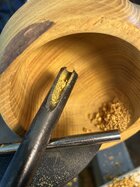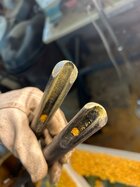Today I spent about 90 minutes creating a first attempt at a bowl gouge and I am quite encouraged with the results.
Briefly: I selected a 16" length of 3/4" scrap rod.
I chucked it in the lathe and drilled a 3/8" hole in the end about 2" deep [about 200 rpm per minute]
Then I used an angle grinder to hog out the metal to the hole.
I ground the end angle at about 60*.
I handled it in a 1.5" oak dowel. I cross cut relief joints on the band saw and held it in place with two hose clamps [overall tool length about 35"]
I was pleased with how the process went and how well it cut Osage orange. It seemed to hold an edge well.
For my next step I am considering quenching it and heat treating it [I have a forge but I have only quenched and heat treated knives]. I don't know how much longer the edge will hold as it seemed to last for several minutes already [ there isn't as much pressure cleaning up the bottom].
If this goes well I am considering making a 40* bowl gouge for roughing.

Briefly: I selected a 16" length of 3/4" scrap rod.
I chucked it in the lathe and drilled a 3/8" hole in the end about 2" deep [about 200 rpm per minute]
Then I used an angle grinder to hog out the metal to the hole.
I ground the end angle at about 60*.
I handled it in a 1.5" oak dowel. I cross cut relief joints on the band saw and held it in place with two hose clamps [overall tool length about 35"]
I was pleased with how the process went and how well it cut Osage orange. It seemed to hold an edge well.
For my next step I am considering quenching it and heat treating it [I have a forge but I have only quenched and heat treated knives]. I don't know how much longer the edge will hold as it seemed to last for several minutes already [ there isn't as much pressure cleaning up the bottom].
If this goes well I am considering making a 40* bowl gouge for roughing.



